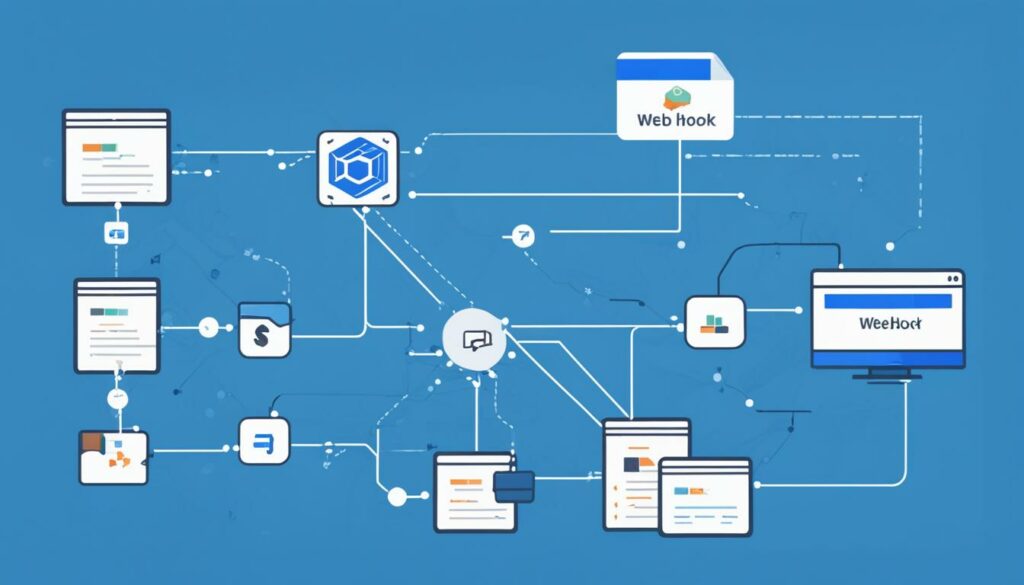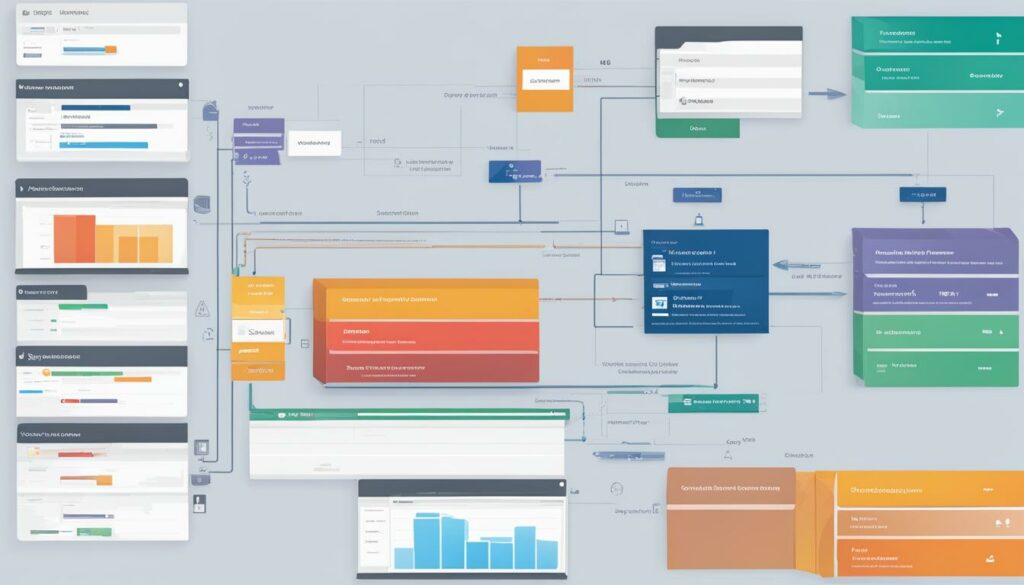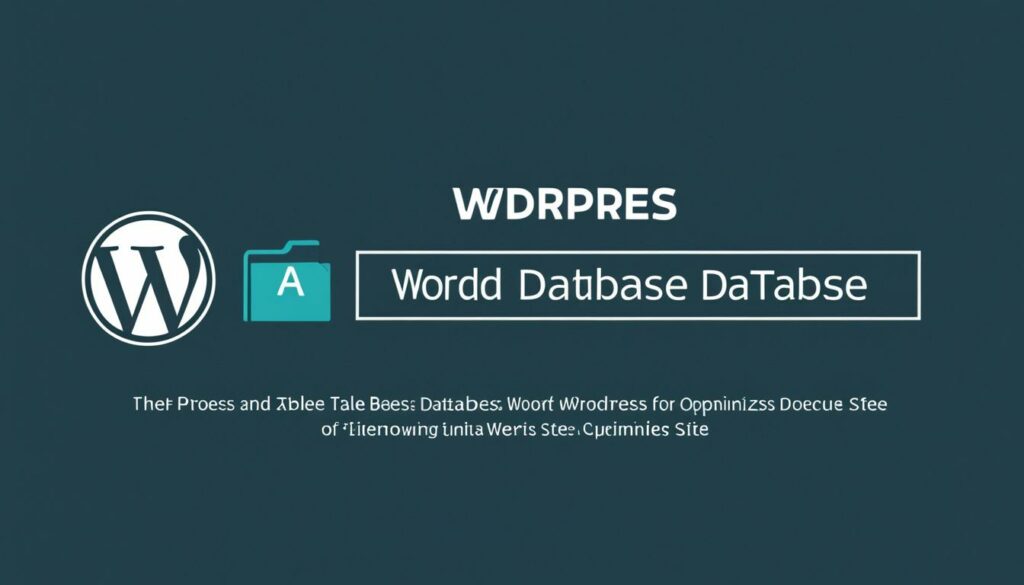Welcome to our comprehensive guide on web hooks! In this article, we will explain what web hooks are, how they work, and why they matter in today’s digital landscape. Whether you’re a developer, marketer, or business owner, understanding web hooks will empower you to automate real-time data flows and unlock the full potential of your applications.
Web hooks have emerged as an event-driven alternative to polling in service-oriented architectures. They enable seamless communication and data exchange between applications without the need for constant requests. Platforms like GitHub have adopted web hooks to enhance their functionality and provide real-time updates.
In this tutorial, we will delve into the essence of web hooks, exploring their benefits, integration possibilities, and best practices for implementation. We will also provide step-by-step instructions on setting up web hooks and highlight the key differences between web hooks and APIs.
Examples and case studies will showcase how web hooks are used in real-world scenarios, such as GitHub notifications, form submissions to email, and e-commerce order notifications. These practical applications will help you visualize the potential of web hooks in various industries and inspire you to implement them in your own projects.
Throughout this guide, we will emphasize the importance of web hooks in achieving real-time communication, enhancing efficiency, and enabling seamless integration. By following best practices and leveraging the power of web hooks, you can optimize your digital processes, improve workflows, and stay ahead in today’s fast-paced world.
Key Takeaways:
- Web hooks are an event-driven alternative to polling, allowing for real-time data exchange between applications.
- They offer benefits such as fresher data, more efficient communication, and lower infrastructure costs compared to polling.
- Web hooks automatically trigger events in response to specific events, while APIs require manual requests for information.
- Setting up web hooks involves defining the triggering event, choosing a webhook provider, configuring the endpoint URL, and testing the setup.
- Web hooks enable real-time communication, flexibility, efficiency, and seamless integration between different platforms.
Now that we have covered the introduction, let’s dive into the essence of web hooks and understand how they work in more detail.
The Essence of Webhooks
Webhooks are a powerful tool in the realm of web development, enabling seamless and real-time communication between applications. Unlike traditional APIs that rely on manual requests for information retrieval, webhooks automate the process by sending automated messages from one application to another when a specific event occurs.
Webhooks offer a range of benefits, including:
- Real-time communication: Webhooks enable instant data exchange between applications, ensuring that information is always up to date.
- Flexibility: With webhooks, you have the freedom to define the specific events that trigger automated messages, allowing for precise control and customization.
- Efficiency: By eliminating the need for manual requests, webhooks streamline the flow of information, saving time and resources.
- Integration possibilities: Webhooks provide integration possibilities with various platforms and services, allowing for seamless collaboration and data transfer.
It’s essential to note the distinction between webhooks and APIs. While both serve similar purposes in facilitating communication between applications, webhooks automatically trigger events based on specific occurrences, while APIs require manual requests for information retrieval. This fundamental difference makes webhooks particularly suitable for real-time interactions.
To illustrate this further, consider the following scenario:
You have an application that relies on real-time updates whenever a new user signs up. With webhooks, you can set up an automated message to be sent from your application to another whenever a new user successfully registers. This instant communication ensures that the receiving application receives the latest user data promptly.
To highlight the differences between webhooks and APIs, refer to the table below:
As shown in the table, webhooks and APIs have distinct characteristics that make them suitable for different use cases. By leveraging webhooks, you can optimize real-time communication and data exchange, ensuring efficient and streamlined interactions between applications.
How Do Webhooks Work?
Webhooks facilitate real-time communication and data exchange between applications. So, how exactly do they work? When an event occurs on the webhook provider’s application, it triggers a webhook, which sends an HTTP request to the webhook receiver. This request contains a payload, typically in the form of JSON data, that carries relevant information about the event.
Once the webhook receiver receives the HTTP request, it processes the payload and performs the necessary actions based on the received data. This could involve updating databases, sending notifications, or triggering specific processes in the receiver application.
After processing the payload, the webhook receiver sends a response back to the webhook provider, confirming the successful receipt and processing of the HTTP request. This confirmation allows the provider to keep track of the webhook’s status and ensure that the data exchange is occurring as intended.
The interaction between the webhook provider and receiver happens in real-time, meaning that the communication happens immediately after the event occurs. This real-time data exchange enables applications to stay updated and synchronized, improving overall efficiency and responsiveness.
To help visualize the process, here is an example of how a webhook works:
Let’s say you have an e-commerce website where users can place orders. Whenever a new order is placed, your webhook provider sends an HTTP request to the webhook receiver, which could be an inventory management system. The payload of the HTTP request contains information about the order, such as the customer’s details, products purchased, and shipping address.
Upon receiving the HTTP request, the webhook receiver processes the payload and updates the inventory accordingly. It might also trigger additional actions, such as sending a confirmation email to the customer or generating a shipping label.
Once the webhook receiver has completed its tasks, it sends a response back to the webhook provider, indicating that the order has been successfully processed. This allows the provider to keep track of the order’s status and take any necessary follow-up actions.
This simplified example demonstrates how webhooks enable efficient and timely data exchange between applications, eliminating the need for manual checks and enabling seamless integration.

| Webhook Provider | Webhook Receiver |
|---|---|
| Triggers events | Receives HTTP request with payload |
| Sends HTTP request with payload | Processes and acts on the payload |
| Receives response | Sends response back to the provider |
Setting Up Webhooks: A Step-By-Step Guide
Setting up webhooks is an essential part of integrating real-time data exchange into your applications. This step-by-step guide will walk you through the process of webhook setup, from defining the triggering event to optimizing your setup for optimal performance.
Step 1: Define the Triggering Event
To begin, determine the specific event that will trigger your webhook. Whether it’s a new user sign-up, an order placement, or a content update, identifying the event is crucial for setting up the webhook accurately.
Step 2: Choose a Webhook Provider
Next, select a reliable webhook provider that suits your needs. Popular webhook providers include Zapier, Integromat, and IFTTT. Consider factors such as ease of use, available integrations, and the provider’s reputation in the industry.
Step 3: Configure the Endpoint URL
Once you have chosen a webhook provider, configure the endpoint URL where the data will be sent. This URL acts as the destination for the webhook payload. Make sure to provide a valid and secure endpoint URL to ensure smooth data transfer.
Step 4: Detail the Payload Data
In this step, specify the data you want to include in the webhook payload. This can range from basic information like user names and email addresses to more complex data structures. Ensure that the payload is well-formatted and contains all relevant data for your application to process correctly.
Step 5: Test the Webhook
After configuring the webhook, it’s crucial to test its functionality. Send a sample event to your webhook and verify if the data is correctly received at the specified endpoint URL. This testing phase ensures that your webhook setup is working as intended.
Step 6: Handle Potential Errors
When working with webhooks, it’s essential to anticipate and handle potential errors. Implement error handling mechanisms to address issues such as failed deliveries or malformed payloads. By handling errors gracefully, you can ensure the reliability and robustness of your webhook integration.
Step 7: Optimize Your Webhook Setup
To maximize performance and efficiency, consider optimizing your webhook setup. Key optimization practices include limiting the size of the payload to reduce bandwidth consumption, securing your endpoint URL with HTTPS, and maintaining comprehensive documentation for future reference.
Best Practices for Webhook Setup:
- Limit the payload size to optimize bandwidth usage.
- Secure the endpoint URL with HTTPS to ensure data privacy.
- Maintain comprehensive documentation for future reference and troubleshooting.
By following these steps and best practices, you can successfully set up webhooks for real-time data integration and automation in your applications.
| Step | Description |
|---|---|
| 1 | Define the triggering event |
| 2 | Choose a webhook provider |
| 3 | Configure the endpoint URL |
| 4 | Detail the payload data |
| 5 | Test the webhook |
| 6 | Handle potential errors |
| 7 | Optimize the webhook setup |
Webhooks vs. APIs
When it comes to communication between applications, two common methods are webhooks and APIs. Webhooks automatically trigger events in response to specific events, while APIs require manual requests for information.
One key difference between webhooks and APIs lies in the way they provide updates. Webhooks offer real-time updates, meaning that when a specific event occurs, the relevant information is immediately sent to the recipient application. On the other hand, APIs require periodic checks or manual requests to fetch new information.
Imagine you have an e-commerce website that needs to retrieve the latest order details from a third-party payment gateway. Using an API, you would need to regularly send requests to the payment gateway’s server to check for new orders. This polling process can be time-consuming and inefficient, especially when dealing with large volumes of data. In contrast, by implementing webhooks, the payment gateway can proactively send real-time updates to your website whenever a new order is placed, eliminating the need for manual requests and ensuring you always have the most up-to-date information.
Webhooks and APIs also differ in how they handle event-triggered communication. With webhooks, the sender application automatically pushes data to the recipient application whenever a specified event occurs. This event-driven model allows for immediate communication and reduces the latency associated with manual requests. APIs, on the other hand, require explicit requests from the recipient application to fetch the desired data. This manual nature of APIs can introduce delays and dependencies on the recipient’s request frequency, potentially slowing down processes.
The choice between webhooks and APIs depends on your specific needs and use cases. If you require real-time updates and efficient event-driven communication, webhooks are a better fit. On the other hand, if periodic checks for data updates and manual request handling align with your requirements, APIs can be a suitable choice.

Why Webhooks Matter
Webhooks play a crucial role in enabling real-time communication and enhancing the efficiency and flexibility of your applications. They provide immediate notifications, eliminating the need for manual checks and ensuring that you stay up to date with the latest information. With webhooks, you can trigger specific actions based on events, automating communication and saving valuable time. Let’s explore why webhooks matter and how they can benefit your workflow:
Real-Time Communication
Webhooks enable instant notifications, allowing you to receive timely updates as soon as specific events occur. This real-time communication ensures that you have access to the most current data and can respond swiftly to any changes or actions required. Whether it’s notifying users about new orders on an e-commerce platform or sending updates for critical events, webhooks facilitate seamless and immediate communication.
Flexibility in Triggering Actions
With webhooks, you have the flexibility to trigger specific actions in response to events. Instead of manually checking for updates or repeatedly polling for information, webhooks automatically initiate actions when predefined conditions are met. This flexibility allows you to streamline your workflow, automate processes, and focus more on high-value tasks, ultimately enhancing your overall productivity.
Efficiency through Automation
By automating communication between applications, webhooks significantly improve efficiency. Instead of relying on manual interactions and periodic checks, webhooks eliminate the need for constant monitoring and reduce the risk of missing critical information. They facilitate seamless data exchange, ensuring that relevant information is delivered precisely when and where it is needed, allowing your team to work more efficiently and effectively.
Seamless Integration between Platforms
Webhooks offer integration possibilities that allow different platforms and applications to work together seamlessly. Through webhooks, you can connect various systems, enabling them to share data and communicate effortlessly. This integration simplifies complex workflows, reduces dependencies, and enhances collaboration, leading to increased productivity and improved overall performance.
In summary, webhooks provide essential functionalities that are crucial for modern applications. They facilitate real-time communication, offer flexibility in triggering actions, enhance efficiency through automation, and enable seamless integration between platforms. By leveraging webhooks, you can optimize your workflow, improve communication, and unlock the full potential of your applications.

Using Webhooks on Your Site
Incorporating webhooks in your web applications can greatly enhance their efficiency and reduce errors, especially when it comes to utilizing third-party services. Webhooks serve as a powerful tool for facilitating seamless communication and data exchange between applications, ultimately leading to improved overall performance and user experience.
With the integration of webhooks, you can automate various processes, ensuring that your application efficiently responds to events and triggers from external systems. This automation allows for real-time updates and eliminates the need for manual intervention, reducing the risk of error and enhancing the accuracy of data transfer.
When using webhooks to connect your application with third-party services, you can improve your application’s overall efficiency by eliminating the need for frequent polling or manual data retrieval. Instead, the webhooks allow for seamless data exchange, ensuring that your application always has the most up-to-date information in real-time.
“By leveraging webhooks, you enable your application to stay in sync with third-party services, reducing the risk of discrepancies or errors caused by delays or outdated data.”
Furthermore, webhooks provide an efficient and reliable means of error reduction. With traditional methods of data retrieval or integration, there is a higher chance of errors occurring during the transmission or processing of data. However, by leveraging webhooks, you can significantly reduce these potential errors and ensure the seamless flow of information between your application and third-party services.
Webhooks offer a level of flexibility that allows you to tailor your application’s integration with third-party services according to your specific needs. You can choose to trigger specific actions based on the events and data received from these services, thus enabling a more customized and efficient workflow.
Overall, incorporating webhooks into your web applications can lead to increased efficiency, reduced errors, and streamlined communication with third-party services. By leveraging the power of webhooks, you can ensure that your application functions at its optimal level, providing an enhanced user experience and maximizing the benefits of your integrated services.
| Benefits of Using Webhooks | Examples |
|---|---|
| Real-time updates | Instant notifications for new leads, orders, or events |
| Automation | Automated data synchronization with CRM platforms |
| Event-driven communication | Immediate triggering of actions based on specific events |
| Streamlined workflows | Efficient integration between applications and services |
Benefits of Webhooks
If you’re looking to enhance your digital processes and improve communication between applications, webhooks offer a range of benefits. By utilizing webhooks, you can enjoy real-time updates, automation of tasks, event-driven communication, and streamlined workflows.
One of the key advantages of webhooks is the ability to receive real-time updates. Instead of constantly polling for new data, webhooks allow you to automatically receive updates whenever a specific event occurs. This real-time information ensures that you have the most up-to-date data at all times, enabling you to make informed decisions and take immediate action.
Automation is another significant benefit of webhooks. By setting up webhooks to trigger specific actions in response to events, you can streamline your processes and eliminate manual tasks. This automation not only saves time but also reduces the risk of errors that might occur with manual intervention.
Event-driven communication is a fundamental aspect of webhooks. Unlike traditional methods where applications rely on manual requests for information, webhooks initiate communication automatically. This event-driven approach means that relevant data is exchanged between applications in real-time, ensuring efficient collaboration and seamless integration.
Webhooks also contribute to streamlined workflows by eliminating unnecessary steps in data exchange. With webhooks, the data flows directly from the source application to the receiving application, bypassing the need for intermediaries. This streamlined communication improves efficiency, reduces latency, and optimizes your overall digital processes.
| Real-Time Updates | Automation | Event-Driven Communication | Streamlined Workflows |
|---|---|---|---|
| Receive instant updates whenever an event occurs. | Automate tasks and eliminate manual intervention. | Enable seamless communication between applications. | Optimize processes and enhance collaboration. |
With all these advantages, it’s no wonder that webhooks have become an essential tool for businesses across various industries. By leveraging real-time updates, automation, event-driven communication, and streamlined workflows, you can take your digital processes to the next level and achieve greater efficiency and effectiveness.
To maximize the benefits of webhooks, it’s crucial to follow best practices for their integration. Discover more about optimizing payloads, securing data transfer, handling errors, and maintaining proper documentation in Section 9: Webhooks Integration Best Practices.

Webhooks Integration Best Practices
When integrating webhooks into your applications, following best practices ensures efficient and secure communication between different systems. By optimizing payload size, securing data transfer, maintaining clear documentation, and implementing proper error handling, you can enhance the effectiveness and reliability of webhook integrations.
1. Payload Optimization
Optimizing the size of your webhook payloads is crucial for efficient data transfer. By reducing unnecessary data and structuring the payload effectively, you can minimize network overhead and improve overall performance.
2. Secure Data Transfer
Securing the transmission of webhook data is essential to protect sensitive information. Using HTTPS to encrypt the data ensures its confidentiality and integrity, preventing unauthorized access and tampering.
3. Documentation
Clear and comprehensive documentation is key to successful webhook integration. Documenting the webhook’s purpose, endpoints, payload structure, and any required authentication or headers helps both developers and users understand and utilize your webhook effectively.
4. Error Handling
Implementing proper error handling mechanisms is crucial for webhook integrations. This includes handling timeouts, network errors, data validation errors, and other potential issues to ensure smooth and reliable communication between applications.
“Proper error handling is essential to prevent data loss and ensure the stability of your webhook integrations.”
Following these best practices will help you optimize the performance, security, and reliability of your webhook integrations, enabling seamless communication and data exchange between applications.
Case Studies and Examples
Webhooks have proven to be highly versatile and practical in various industries. Let’s explore some popular examples that showcase the real-world applications of webhooks:
GitHub Webhooks for Event Notifications
GitHub, the popular platform for version control and code collaboration, utilizes webhooks to provide real-time event notifications. Developers can set up webhooks to receive instant notifications whenever certain events occur within their repositories, such as new commits, pull requests, or issues. This allows developers to stay updated on important changes and take immediate actions, enhancing their workflow efficiency.
“GitHub webhooks have revolutionized how developers collaborate on projects. With real-time event notifications, we can now act swiftly and efficiently, ensuring seamless collaboration and smooth code deployment.”
– Jane Smith, Senior Developer at ABC Company
Form Submissions to Email via Webhooks
Webhooks are commonly used to streamline form submissions and automate email notifications. By setting up webhooks, form data captured on websites can be instantly transmitted to email inboxes. This eliminates the need for manual data handling and ensures timely responses to user inquiries or requests. Businesses and organizations can improve their customer service and lead management processes by leveraging webhooks for form submissions to email.
E-commerce Order Notifications with Webhooks
E-commerce platforms harness the power of webhooks to provide instant notifications of new orders. When a customer makes a purchase, webhooks can trigger notifications to both the store owner and the customer, alerting them about the successful order and initiating subsequent processes like order fulfillment and shipping. These real-time order notifications enhance the overall customer experience and enable businesses to manage their operations efficiently.
These examples demonstrate how webhooks can be effectively employed across different industries to enable real-time communication, automate processes, and optimize workflows. By leveraging webhooks, businesses can achieve enhanced efficiency, improved customer experiences, and streamlined operations.
Conclusion
Understanding webhooks is crucial for automating real-time data flows between your applications. By utilizing webhooks, you can streamline your workflows, improve communication, and enhance the efficiency of your digital processes. To maximize the benefits of webhooks, it’s important to follow best practices and implement them correctly.
Webhooks offer a wide range of applications and integration possibilities. Whether you’re looking to receive real-time updates, automate tasks, or trigger event-driven communication, webhooks provide the flexibility and efficiency you need. By integrating webhooks into your web applications, you can enhance their performance, reduce errors, and optimize the user experience.
To ensure successful integration, follow step-by-step guides and documentation provided by webhook providers. Optimize the payload size, secure data transfer, and handle errors effectively. By implementing these best practices, you can establish reliable and secure communication channels between your applications.
FAQ
Q: What are webhooks?
A: Webhooks are automated messages sent from one application to another when a specific event occurs. They enable real-time communication between applications, offering flexibility, efficiency, and integration possibilities.
Q: How do webhooks work?
A: After an event occurs on the webhook provider’s app, a webhook sends an HTTP request to the webhook receiver containing a payload, which is often in the form of JSON data. The receiver then sends a response back to the provider, confirming the success of the request. This process allows for real-time communication and data exchange between applications.
Q: How do I set up webhooks?
A: Setting up webhooks involves defining the event that triggers the webhook, choosing a webhook provider, configuring the endpoint URL where the data will be sent, detailing the payload data, testing the webhook, handling potential errors, and optimizing the setup. Best practices include limiting payload size, securing the endpoint URL, and maintaining documentation.
Q: What is the difference between webhooks and APIs?
A: Webhooks automatically trigger events in response to specific events, while APIs require manual requests for information. Webhooks offer real-time updates, while APIs require periodic checks for new information.
Q: Why are webhooks important?
A: Webhooks are essential for real-time communication, providing immediate notifications and reducing the need for manual checks. They offer flexibility in triggering specific actions, improve efficiency by automating communication, and enable seamless integration between different platforms.
Q: How can webhooks be used on my website?
A: Incorporating webhooks in your web applications can increase efficiency and reduce errors when using third-party services. Webhooks facilitate communication and data exchange between applications, enhancing overall performance and user experience.
Q: What are the benefits of using webhooks?
A: The benefits of using webhooks include real-time updates, automation of tasks, event-driven communication between applications, and streamlined workflows. Webhooks enable seamless integration and improve the efficiency and effectiveness of digital processes.
Q: What are the best practices for webhooks integration?
A: Best practices for webhooks integration involve optimizing payload size, securing data transfer with HTTPS, maintaining clear documentation, and implementing proper error handling. These practices ensure efficient and secure communication between applications.
Q: Can you provide any examples of webhooks in action?
A: Popular examples of webhooks in action include GitHub’s use of webhooks for event notifications, using webhooks to send form submissions to email, and e-commerce platforms utilizing webhooks to notify users about new orders. These examples demonstrate the versatility and practical applications of webhooks in various industries.
Q: How can I better understand and utilize webhooks?
A: Understanding webhooks is essential for automating real-time data flows between applications. By utilizing webhooks, organizations can streamline workflows, improve communication, and enhance the efficiency of their digital processes. Implementing best practices and following step-by-step guides can help maximize the benefits of webhooks and ensure successful integration with various platforms.












